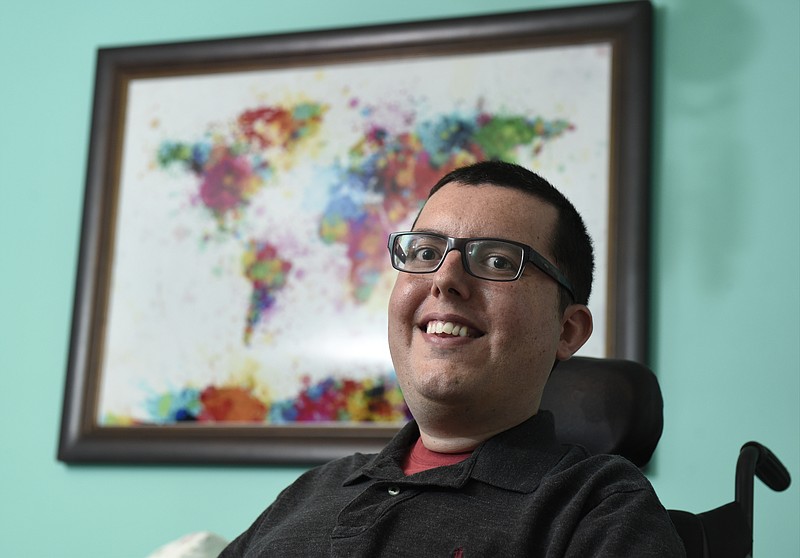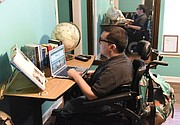Photo Gallery
Worldwide by WheelchairLafayette, Ga., native doesn't let muscular dystrophy stop him from traveling around the world.
Travel tips
Cory Lee Woodard's tips for flying in a wheelchair:1. Book your trip as far in advance as possible, preferably four to six months before departure date.2. Call the airline and request bulkhead seating, which is the front row of economy class and is reserved for wheelchair users by most airlines. It has extra legroom and is more spacious than regular seats, which makes transferring into the seat easier.3. Arrive extra early to the airport. Most airlines recommend arriving an hour before a domestic flight and two hours before an international flight. For wheelchair users, add an hour to that because it will take more time to get through security.4. Put signs on your wheelchair with instructions for the plane crew. The signs should tell them to not take the wheelchair’s batteries out (if they aren’t removable) and how to turn the wheelchair onto manual mode. Also, if you’re traveling internationally, it may be worth writing the notes in that country’s native language to avoid confusion.5. Take parts of your wheelchair — such as your footrests, joystick, and headrest — in a separate carry-on bag. Also, take your wheelchair seat cushion and sit on it during the flight. It will be much more comfortable than the bottom of the plane seat.6. Book your airport transportation at your destination in advance. When you get to your final destination, the last thing that you’ll want to do is hunt a wheelchair-accessible taxi at the airport to take you to your hotel. That process can take a very long time in some places. Research before leaving your house and book the accessible taxi in advance so that it’ll be waiting for you when you arrive.› For tips on traveling by plane, train, bus and ferry all over the world, see Woodard’s website Curb Free with Cory Lee: A Wheelchair Travel Blog at curbfreewithcorylee.com. His eBook, “Air Travel For Wheelchair Users,” can be bought at Amazon, Barnes and Noble online and iTunes.
Cory Lee Woodard's muscular dystrophy put him in a wheelchair at age 4, but it hasn't kept him from swimming in Iceland's Blue Lagoon or enjoying Malibu beaches.
Now, at age 25, his highly successful travel blog, Curb Free with Cory Lee, has sent him around the world a few times and won him more than 12,000 Twitter followers, 4,500 Facebook fans and over 8,500 Instagram followers. Advertising revenues from the blog, sponsorships and sales from his eBook, "Air Travel for Wheelchair Users," fund his trips. This month, the Lafayette, Ga., native is heading to Finland.
He names the alarmingly perky Travel Channel host Samantha Brown as "my No. 1 idol" as far as travel journalism is concerned. And, while Woodard is sweet and sunshine-y, his optimism is tempered by reality.
"Muscular dystrophy is a disease that worsens as you grow older, doctors tell me, so I am trying to travel as much as I can now while I'm young," Woodard says with no hint of drama or self-pity.
His success is still very new. When he graduated college in 2013 with a marketing major, his job search was discouraging. He designed a beautiful layout for his website and decided to focus on it.
"If it wasn't able to support me financially in a year, I promised myself I'd put it aside," he says. "I made my deadline because my first piece that went viral was the 10 Most Wheelchair Accessible Beaches. The LA Times travel editor interviewed me about it in November 2014. Then the advertising revenue and sponsorships began coming."
He plans his global treks from a pretty, white-frame house near a big, dark-green pond surrounded by evergreens. To get there is a long, winding drive past horse farms and fields of cattle. His schoolteacher mother cultivated his love of travel with road trips and a dazzling high school graduation gift - a tour of Germany's fairytale Black Forest villages, as well as Munich and Frankfurt.
Woodard also won trips to the 2007 Global Young Leaders Conference in Washington, D.C. and President Barack Obama's 2004 inauguration. He interned at Disney World, where his job was to entertain children waiting in a gargantuan line to meet Winnie the Pooh and Mickey Mouse.
"It was fun! Really!" he insists, laughing. "Actors had the hardest job in those heavy costumes in summer heat; they would undress and a new Pooh and Mickey would take over every 30 minutes, the heat was so intense."
He learned that wheelchairs get to go to the head of the lines and, with the exception of roller coasters, most rides were wheelchair-accessible. He blogged what he learned.
"It's really not that easy to find a lot of wheelchair travel information in one place; Germany's tourism website is wonderful and has maps videos on where to find ramps and elevators at historic sites," Woodard says. "But most tourism bureaus don't even think of mentioning it."
Indeed it's difficult to find any specific tips for wheelchair users even at AAA's Chattanooga office or its website. It would help the travel industry to know more about what disabled travelers need, if only to avoid excruciating ordeals like that of business traveler D'Arcee Neal, whose cerebral palsy requires a wheelchair.
Passengers normally check their wheelchairs as baggage, then the airline loans them an "aisle chair" narrow enough to roll between the seat rows. In an interview on CNN, Neal says he waited for all the passengers to disembark then waited another 15 minutes for an aisle chair. When the plane crew ignored him, he was forced to crawl down the aisle of the plane to disembark. The crew watched but never made an offer of help, he said.
Neal never filed a complaint. A flight attendant who was a witness reported it to her supervisors, and United Airlines issued Neal a public apology last October. Sadly, he was more surprised by the apology than having to crawl down a plane to its door.
"Quite frankly, I was just shocked (by the apology), because this had happened a couple of times before with various airlines and no company ever bothered to apologize," he told CNN.
Woodard travels with his mother, his best friend in Germany or an adult caregiver, so he always has someone to help him in and out of the wheelchair and to look out for him. But he realizes many wheelchair travelers, like Neal, are going solo.
"There are some places you realize are just not going to be practical for you in Europe," Woodard says. "Paris is one of my favorite trips of all time. But the Metro (subway), which works perfectly for most tourists, can be terrible for anyone in a wheelchair. Elevators are almost impossible to find. The only wheelchair-accessible taxi I could find cost 650 euros ($709) to book for the day.
"I share what I find out on my blog; it can be really difficult to figure out what is wheelchair accessible and what isn't if you look at most tourism sites."
For example, those beautiful Belle Epoque train stations in France's Brittany, Normandy and Comte regions often have flights of stone steps to the train platform but no elevators, he says.
But in Australia's Sydney and Melbourne, "every historic site, every building, club, restaurant, hotel seemed to be wheelchair accessible," he says, beaming happily at the memory.
He believes such accommodations are the future for disabled travelers. Technology is spawning wheelchairs that handle sandy beaches, volcanic rock and muddy forests. And retired baby boomers who can afford to travel want to do so despite bad hips and bum knees, Woodard notes.
Meanwhile, he continues his determined race with time and the disease that attacks his mobility but not his thirst for adventure.
"I have two big dream trips: Antarctica and an African safari," Woodard says, eyes glowing. "Antarctica has no wheelchair accessible tours, so that is a faraway dream. But I found two wheelchair-accessible ones in Kenya and Tanzania. They are too expensive now, but one day I honestly believe it will happen."
Contact Lynda Edwards at ledwards@timsfreepress.com or 423-757-6391.

